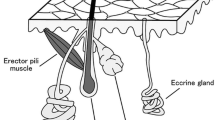Abstract
Objectives
Idiopathic palmar-plantar hyperhidrosis is characterized by excessive sweating of the palms and feet, and is commonly treated by transthoracic regional sympathicotomy. As the condition is believed to be due to a high sudomotor drive, we wanted to assess the firing properties of individual sudomotor neurones in this state of sympathoexcitation, extending our recent work on other pathologies associated with high sympathetic nerve activity.
Methods
Single-unit recordings were made from eight sudomotor neurones supplying the fingers via tungsten microelectrodes inserted percutaneously into the median nerve at the wrist or upper arm.
Results
Typical of sudomotor, muscle vasoconstrictor and cutaneous vasoconstrictor neurones recorded in healthy individuals in states of high sympathetic drive, all units had low firing probabilities (active in only 30.0 ± 6.7 (SE) % of cardiac intervals) and primarily fired only once per heart beat. The percentage of cardiac intervals in which the neurones generated 1, 2, 3 or 4 spikes was 60.4 ± 6.3, 22.9 ± 3.9, 9.7 ± 2.1 and 3.4 ± 1.3%, respectively. For comparison, these values were 77.6 ± 7.7, 15.0 ± 4.1, 4.6 ± 2.3 and 1.8 ± 1.3% for eight sudomotor neurones innervating the hairy skin of the foot during thermally-induced sweating in normal subjects.
Interpretation
We conclude that the firing properties of spontaneously active sudomotor neurones in subjects with hyperhidrosis are similar to those of sudomotor neurones active during thermal sweating, reflecting an increase in central sympathetic drive to the sweat glands in hyperhidrosis.


Similar content being viewed by others
References
Alric P, Branchereau P, Berthet JP, Léger P, Mary H, Mary-Ané C (2002) Video-assisted thoracoscopic sympathectomy for palmar hyperhidrosis: results in 102 cases. Ann Vasc Surg 16:708–713
Bini G, Hagbarth K-E, Hynninen P, Wallin BG (1980) Thermoregulatory and rhythm-generating mechanisms governing the sudomotor and vaoconstrictor outflow in human cutaneous nerves. J Physiol 306:537–552
Bini G, Hagbarth K-E, Hynninen P, Wallin BG (1980) Regional similarities and differences in thermoregulatory vaso- and sudomotor tone. J Physiol 306:553–565
Edin BB, Bäckström PA, Bäckström LO (1988) Single unit retrieval in microneurography: a microprocessor-based device controlled by an operator. J Neurosci Meth 24:137–144
Elam M, Macefield VG (2001) Multiple firing of single muscle vasoconstrictor neurons during cardiac dysrhythmias in human heart failure. J Appl Physiol 91:717–724
Elam M, Macefield VG, McKenzie D (2002) The firing pattern of single muscle vasoconstrictor neurons in awake patients with the obstructive sleep apnoea syndrome. J Appl Physiol 93:297–303
Hertzman AB (1959) Vasomotor regulation of cutaneous circulation. Physiol Rev 53:948–1017
Iwase S, Ikeda T, Kitazawa H, Hakusui S, Sugenoya J, Mano T (1997) Altered response in cutaneous sympathetic outflow to mental and thermal stimuli in primary palmoplantar hyperhidrosis. J Autonom Nerv Syst 64:65–73
Kaufmann H, Saadia D, Polin C, Hague S, Singleton A, Singleton A (2003) Primary hyperhidrosis: evidence for autosomal dominant inheritence. Clin Autonom Res 13:96–98
Krogstad AL, Skymne A, Pegenius G, Elam M, Wallin BG (2005) No compensatory sweating after botulinum toxin treatment of palmar hyperhidrosis. Br J Dermatol 152:329–333
Kunimoto M, Kirnö K, Elam M, Karlsson T, Wallin BG (1991) Neuroeffector characteristics of sweat glands in the human hand activated by regular neural stimuli. J Physiol 442:391–411
Kunimoto M, Kirnö K, Elam M, Karlsson T, Wallin BG (1992) Neuro-effector characteristics of sweat glands in the human hand activated by irregular stimuli. Acta Physiol Scand 146:261–269
Kunimoto M, Kirnö K, Elam M, Karlsson T, Wallin BG (1992) Non-linearity of skin resistance response to intraneural electrical stimulation of sudomotor nerves. Acta Physiol Scand 146:385–392
Kwong KF, Hobbs JL, Cooper LB, Burrows W, Gamliel Z, Krasna MJ (2008) Stratified analysis of clinical outcomes in thoracoscopic sympathicotomy for hyperhidrosis. Ann Thorac Surg 85:390–393
Lambert E, Hotchkin E, Alvarenga M, Pier C, Richards J, Barton D, Dawood T, Esler M, Lambert G (2006) Single-unit analysis of sympathetic nervous discharges in patients with panic disorder. J Physiol 570:637–643
Macefield VG, Elam M, Wallin BG (2002) Firing properties of single postganglionic sympathetic neurones recorded in awake human subjects. Autonom Neurosci 95:146–159
Macefield VG, Wallin BG (1996) Discharge behaviour of single sympathetic neurones innervating human sweat glands. J Autonom Nerv Syst 61:277–286
Macefield VG, Wallin BG (1999) Respiratory and cardiac modulation of single vasoconstrictor and sudomotor neurones to human skin. J Physiol 516:303–314
Macefield VG, Sverrisdottir YB, Rundqvist B, Wallin BG, Elam M (1999) Firing properties of single muscle vasoconstrictor neurones in the sympathoexcitation associated with heart failure. Circulation 100:1708–1713
Macefield VG, Wallin BG (1999) Firing properties of single vasoconstrictor neurones in human subjects with high levels of muscle sympathetic drive. J Physiol 516:293–301
Macefield VG, Wallin B, Vallbo ÅB (1994) The discharge behaviour of single vasoconstrictor motoneurones in human muscle nerves. J Physiol 481:799–809
Rex L, Claes G, Drott C, Pegenius G, Elam M (1998) Vasomotor and sudomotor function in the hand after thoracoscopic transection of the sympathetic chain: implications for choice of therapeutic strategy. Muscle Nerve 21:1486–1492
Saadia D, Voustianouk A, Wang A, Kaufmann H (2001) Botulinum toxin type A in primary palmar hyperhidrosis: randomized, single-blind, two-dose study. Neurol 57:2095–2099
Sciuchetti JF, Corti F, Ballabio D, Angeli MC (2008) Results, side effects and complications after thoracoscopic sympathetic block by clamping. The monza clinical experience. Clin Auton Res 18:80–83
Weksler B, Luketich JD, Shende MR (2008) Endoscopic thoracic sympathectomy: at what level should you perform surgery? Thorac Surg Clin 18:183–191
Wolosker N, Yazbek G, Milanez de Campos JR, Kauffman P, Ishy A, Puech-Leão P (2007) Evaluation of plantar hyperhidrosis in patients undergoing video-assisted thoracoscopic sympathectomy. Clin Auton Res 17:172–176
Acknowledgments
This work was supported by the National Health and Medical Research Council of Australia.
Author information
Authors and Affiliations
Corresponding author
Rights and permissions
About this article
Cite this article
Macefield, V.G., Sverrisdottir, Y.B., Elam, M. et al. Firing properties of sudomotor neurones in hyperhidrosis and thermal sweating. Clin Auton Res 18, 325–330 (2008). https://doi.org/10.1007/s10286-008-0507-7
Received:
Revised:
Published:
Issue Date:
DOI: https://doi.org/10.1007/s10286-008-0507-7




